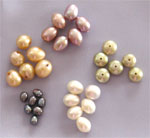 Pearls speak to me. As well they should. Why? Although it often confuses folks who only know me as Peg, my given name, and the one I use professionally & when signing documents, is Margaret. If you looked it up in those baby naming websites or books, you’d find that Margaret means pearl. I was born in June, and June’s modern and ayurvedic birthstone is – you guessed it – pearls. So it only makes sense that I start this blog by talking about pearls.
Pearls speak to me. As well they should. Why? Although it often confuses folks who only know me as Peg, my given name, and the one I use professionally & when signing documents, is Margaret. If you looked it up in those baby naming websites or books, you’d find that Margaret means pearl. I was born in June, and June’s modern and ayurvedic birthstone is – you guessed it – pearls. So it only makes sense that I start this blog by talking about pearls.
Pearls are traditionally made by oysters that have a grain of sand or other irritant in their shell. I’m guessing this feels as big to an oyster as that boulder that turns out to be a tiny stone feels in my sneaker. Oysters aren’t very good at spitting things out, so they protect themselves by covering up the irritant. They don’t have access to silk or other natural lovelies to cover it, so they use what’s at hand – nacre, the same material that they use to make their own shells. Over the course of months or years, the oyster adds more and more nacre to the original bit, ultimately producing a lovely pearl. The nacre produces a lovely sheen and gloss, both on the oyster’s shell and on the pearl itself.
The original pearls were found by accident when folks were simply looking for food. (When I look for food from nature, the best I can hope for is a gem of a red raspberry, not something I can turn into an earring!) The oysters they opened to this lovely surprise lived in the ocean – salt water. These days, almost all pearls you’ll see are cultured freshwater pearls. Pearl harvesters carefully sneaks open the shell of an oyster and nip its flesh, sometimes inserting an irritant, often knowing that the wound itself will cause the oyster to begin building up nacre and produce a pearl.
 These days you’ll see pearls in lots of shapes from the traditional round or oval shape to coins, sticks, crosses, and more. You’ll also find pearls in colors ranging from white to pink, lavender, grey, green, blue, gold, and more. Unless you’re spending LOTS of money to buy natural colors (black, cream, grey, and more) the colored pearls you’re getting have likely been dyed. This is particularly true of dark or bright colors. White pearls may have been bleached to provide a uniform color. I typically use only white or subtle colors in my jewelry, and tend to stay with fairly traditional shapes.
These days you’ll see pearls in lots of shapes from the traditional round or oval shape to coins, sticks, crosses, and more. You’ll also find pearls in colors ranging from white to pink, lavender, grey, green, blue, gold, and more. Unless you’re spending LOTS of money to buy natural colors (black, cream, grey, and more) the colored pearls you’re getting have likely been dyed. This is particularly true of dark or bright colors. White pearls may have been bleached to provide a uniform color. I typically use only white or subtle colors in my jewelry, and tend to stay with fairly traditional shapes.
Oh, yeah, and if you & your sweetie have an anniversary coming up, pearls make great anniversary gifts, one that’s sure to earn you hugs and kisses. When the only pearls available were wild-harvested salt water pearls, they were really expensive and were therefore the traditional gift for the 30th anniversary. With the advent of affordable cultured pearls, they’ve moved up to the 12th anniversary in modern times.
Ok, enough about how pearls are made – let’s get to pearls’ symbolism, medicinal properties, & healing with pearls. Pearls symbolize purity, innocence, & faith. They enhance integrity, sincerity, truth, loyalty, and wisdom. They can help you see the good parts of yourself so that you can both love yourself and accept love from others. Their soft glow can help clear your mind and bring calming reflection, and can bring soft, healing energy to your meditation practice, or just help you slow down a bit and breathe. Those who do chakra work may want to use pearls to help with the heart chakra. Over the centuries people have used pearls to help ease childbirth, protect from infection, and to help in healing a variety of ailments from eye problems to indigestion.
Can pearls really do all that? I don’t know. But I do know there are lots of things that greater minds than mine don’t understand, and the healing power of gemstones is one of them.
Get free gemstone information about other gems and their properties.


Leave a Reply